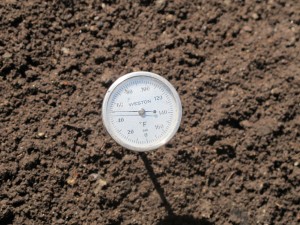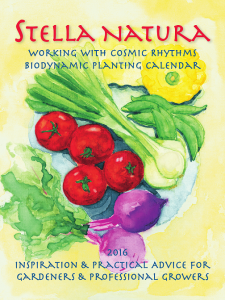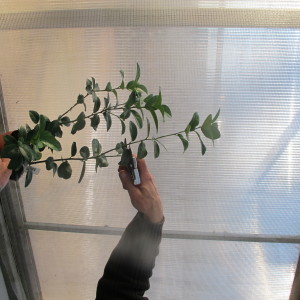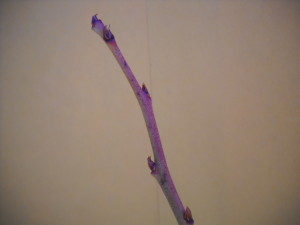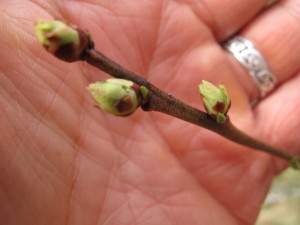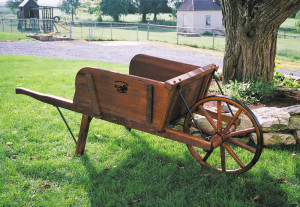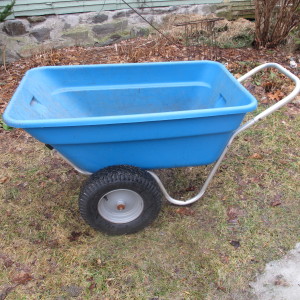Getting the Vegetable Garden Ready
I talked to a gardening friend who has already started planting a few things in his vegetable garden. Not me! Despite a few warm sunny days, it is way too cold and wet in my garden to do much of anything. Seeds will rot in cold, wet soil. Here’s what I’m doing – or not doing.
Technically, spring is here, but the soil temperature in my garden is in the thirties, even when the air gets into the fifties or warmer. We need consistently warm temperatures before I will plant outdoors because it takes time to warm up the soil. I want the soil to reach 50 degrees or warmer before I plant.
Yes, I take my soil’s temperature, much as I would a sick puppy or a child trying to avoid school. I have a thermometer that looks like an old analog oven thermometer: a steel probe with a round button with a dial on top that shows the temperature. Mine was designed for use in compost piles, so the probe is a couple of feet long. You can look at your local garden center, or order one from Gardeners Supply Company (www.gardeners.com) in Burlington, VT.
I’m not ready to rake off the leaves I spread on my vegetable beds last fall. In October I weeded my vegetable garden and then covered it with 4 to 6 inches of leaves that I’d run over with the lawnmower and raked up. The leaves kept the soil from washing from my mounded raised beds into the walkways (the beds don’t have planks to contain the soil).
Unfortunately, the layer of leaves is also an insulator, so the soil will stay colder than bare soil until I remove it. But the leaves inhibit weeds from growing, too. That’s a good thing. Since my soil is still pretty soggy, I don’t want to walk in the garden or disturb the soil.
Soil is actually a bit fragile at this time of year – step on it (or rototill it) and you can ruin its structure. So the leaves keep weeds from growing until I rake them off in late April or early May.
Once the leaves are off the beds and raked into the pathways, two kinds of weeds will grow: annual weeds and perennial weeds like dandelions and witch grass. Annual weeds grow from seeds and are easy to kill: you can run a sharp hoe just below the surface, slicing off the tops from the roots. That will kill annual weeds when they are small.
If you don’t get around to hoeing your beds and the weeds are well established, you could toast them! That’s right, cover a bed with clear plastic, seal the edges with soil, and in just a day or two of hot sunshine, they will be toast. I’ve measured the temperature in a bed being solarized, and on a 60-degree day, the temperature got over 100 degrees.
Perennial weeds need to be pulled. Their roots contain stored energy from last year, and generally even a scrap of root can regenerate and start a new plant. That is one of the reasons I don’t recommend rototilling. Chop up witch grass roots and each piece with a node will produce a new plant if it is within a few inches of the soil surface. It’s true that plowing a field and turning the sod under a foot of soil will kill most grasses, but that’s different than rototilling.
Meanwhile, indoors, it’s almost time to start planting. Generally I recommend starting most things 6 to 8 weeks before I put them outside. I plant tomatoes outdoors in early June. So April 10 is my planting date most years. I use a biodynamic calendar called Stella Natura (www.stellanatura.com) to advise me about planting dates. It uses the planets, stars and the moon to determine good times for planting fruits (tomatoes and peppers), roots (carrots and potatoes), flowers (artichokes and cauliflower) and leaves (lettuce and kale).
This year April 10th is a root day, but the two days before, according to Stella Natura, are fruit days up until 2pm on April 9th. At that point there is a blackout period until 6pm, and I will definitely not plant anything then. My informal experiments with blackout days have shown me that there is a significant disadvantage to planting then.
So what should you do if you didn’t weed and prepare your beds last fall? Start weeding, a little every day, as soon as your beds dry out. An easy way to see if your soil is ready to work is to grab a handful of soil and squeeze it. Hold that ball of soil, and tap it with a finger. If the soil is ready to work, it should crumble. If not, wait.
And when your soil is ready to work, think about creating some mounded, raised beds. You can do this by loosening the soil with a garden fork, then raking the loose soil into beds that are about 3 feet wide and stand up 4 to 6 inches above the walkways. Add a thick layer of compost on top, and scratch it into the soil at the top surface, and you’ll be ready to plant.
We all want to start gardening now, but do wait until your soil is as ready as you are!
Read Henry’s blog by going to https://dailyuv.com/
Growing Tropical Fruits
Last fall in my weekly newspaper column I commented that, if I’d been a good boy all year, I hoped Santa would bring me lemon or lime tree, one that would bear fruit indoors. Santa did not do so, though I can’t imagine why. But many kind readers emailed me saying, “Go to Logee’s Greenhouse (www.logees.com) in Danielson, Connecticut. They will have just what you want.” So after presenting at the Rhode Island Flower Show in February, I went to Logee’s. I got what I wanted – and more.
I met Byron Martin, whose grandfather started Logee’s in 1892. He showed me plants that had been alive longer than he had – some dating back to his grandfather’s days. By now the business has 14 greenhouses – including the original greenhouse.
Byron literally grew up in the greenhouses, and is a vast reservoir of knowledge. He also has a good sense of humor. In one greenhouse he showed us the Miracle Berry plant and invited us to taste the fruit. “Just chew it a little”, he said. “Spit out the seed.” It was nothing remarkable, pleasant, but nothing special.
Later, in a different greenhouse, Byron picked a lemon, cut it open and offered me a piece. “Try this,” he said. “It’s nothing like any lemon you’ve ever tasted.” Wow. It was sweet. I mean sweeter than an orange. He grinned and explained that the Miracle Berry changes the way your taste buds perceive flavors. The regular lemon he offered tasted sweet and delicious.
In addition to running a fabulous tropical greenhouse, Byron is also the co-author with Laurelynn Martin of Growing Tasty Tropical Plants in Any Home, Anywhere (Storey Publishing, 2010). This book really does tell you everything you need to know about growing tropical fruits. I wish I’d gotten it years ago.
The book explains not only how to do things, but why. I like that. So, for example, I knew that one shouldn’t transplant a small plant into a big pot, just go to the next size. It’s fine to move a plant from a 4 inch pot to a 6 inch pot, not a 12-inch pot. But I never knew why.
The book explains that a small plant in a big pot may develop root rot. Its small root system will not suck out the water from the far reaches of the pot, so the potting soil will remain cool and wet, and that can easily promote root rot. Makes sense.
Growing Tasty Tropical Plants has tips for success, plant by plant and best bets for beginners. It tells you how to grow coffee, tea and bananas. Cinnamon? Sure, you can do it. And what about those avocadoes from the pits we all have started? No, the book explains, those will never produce fruit – but there are kinds of avocado that will give you fruit.
As an organic gardener I appreciate that the Martin’s book explains easy, safe ways to control pests and diseases. Neem oil is produced by a tropical tree and offers pest control for many insects without resorting to synthetic chemicals. And a sharp blast of cold water can greatly reduce the population of aphids or spider mites. (I’ve been known to shower with my house plants).
So what am I growing now? I started with a key lime. This will produce fruit on a 2-foot tall plant, blooming in late winter or early spring and producing fruit in the fall into winter. The book explains that it needs temperatures of 60 degrees or more, as much sun as possible, and well-drained potting mix. It will not do well in consistently wet soil mix.
Then I got a Meyer Lemon. With proper pruning it will produce fruit when just three feet tall and is on the “Best Bets for Beginners” list. Like the lime, this plant will go outside in full sun for the summer, and can tolerate temperatures down to 50 degrees. At Logee’s, most of their lemons grow in 12-inch baskets high in the greenhouse as they love heat. Each of those plants produces about 30 lemons a year!
And of course I had to get a Miracle Berry (Synsepalum dulcificum). According to the book, if kept in full sun and fertilized monthly, it fruits heavily twice a year. And, according to some, chewing on a mature fruit will change the taste of lousy red wine into something a wine aficionado dreams of.
Byron gave me a bay plant so I can have leaves for use in the kitchen, and a neem tree just for fun. I knew the neem tree from my years in Africa, its native home. Interestingly, Bambara farmers in Mali called it the equivalent of the “manure tree”, having figured out that it improves the soil (by fixing nitrogen). According to Byron’s book, neem oil will smoother and eradicate white flies, mealybugs, thrips and more. I bought a small bottle of it.
In a year or two I should be harvesting lemons and limes. I have a good sunny window for the winter, and they will go out in the summer. And if you want to try some of these things, think about a road trip to Logee’s.
Henry is now blogging regularly. Go to https://dailyuv.com/
Pruning Blueberries
March is a good time to prune not just fruit trees, but also your blueberries. Blueberries here in New England are relatively slow growing, so they don’t need to be pruned every year. But they do need help from time to time.
Ready to prune? Your first question should be,” Has the soil thawed and dried out enough to walk around the bushes without damaging the soil?” This is important. You can damage soil structure and roots by walking on soil that has thawed, but has a layer of frozen soil beneath it. Also if the soil is squishy, making sounds or leaving footprints, you should stay away. Yes, I know you want something to do outside on a warm spring day. But stay away from the blueberries, off the lawn and out of the garden until soil has dried out.
Before making your first cut you need to know the difference between leaf buds and fruit buds. A branch that has few or no fruit buds is a good candidate for your pruners. Snip it off, and it will open up the bush, allowing sunshine to get to the productive branches.
Fruit buds are fat and leaf buds are not, they are slim and pointy. Simple as that. The rounded fruit buds generally produce a cluster of berries, not just a single berry, and you will certainly lose some berries when you take off a branch, it’s inevitable. But let the number of fruit buds on a branch guide you as you make your cuts.
Whether pruning blueberries or apples or pears, you should never cut branches in a way that leaves stubs. Branches heal at their point of origin, either at the trunk or a bigger branch. On larger branches you may notice a larger, almost swollen area called the branch collar; they should remain when pruning any type of branch. If you cut off a branch an inch from the branch collar, the stub will need to rot back to the branch collar before it heals. In the meantime pests or diseases may be attracted to the dying wood.
Pruning is the ultimate game of choices for the gardener. Remove this branch or that? Here are some guidelines for making your choices.
- Removing a few larger branches is generally better than making many small cuts.
- First, remove any dead branches. They don’t count in your calculation of how many branches can be removed – they are not contributing anything to the plant’s wellbeing. It is generally accepted that you can remove a quarter to a third of tree or shrub’s leaves in one year. You can identify a live branch even in winter by rubbing it gently with your thumbnail. If you expose a green layer, it’s alive.
- When deciding between two branches, remove the older, less vigorous branch and leave younger stems, which on blueberries often have a green or reddish color.
- Prune away branches that are damaged or rubbing against another branch.
- In general, branches should be grow out, away from the center of the bush. Branches that aim into the middle will eventually cause problems.
- Blueberries sometimes develop a viral infection that causes “witches brooms.” These are masses of fine twigs growing on one branch. Remove the entire thing and put it in the trash, or burn it.
Blueberries really are easy to grow. They need full sun, which means a minimum of six hours per day. But most importantly, they need very acidic soil. Now would be a good time to collect a soil sample and send it off for testing at your state Cooperative Extension laboratory. You can download the form on-line, just Google “soil testing” and your state.
If your soil is not acidic enough, you can add elemental sulfur. This is fine for organic gardeners, too, as it is mined from the earth, not manufactured in a chemical plant.
Changing the soil pH may take you a number of years. It is better to add some elemental sulphur this year, and again next year and in later years rather than dumping too much on at once. Your ultimate goal is a pH in the range of 4.0 t0 5.0. The scale is logarithmic, meaning that 4.0 is ten times more acidic than 5.0, and a hundred times more acidic than 6.0. Seven on the scale is neutral.
My last bit of advice, and one I don’t follow well myself, is to keep the root zone of the blueberries weed free. Mulching with a thick layer of chipped branches is the best way to do so, and I’m going to do so this year!
So do some pruning this year, your blueberries will develop into more vigorous plants in just a year or two. And the rules for pruning blueberries can be applied to your apples, crabapples, plums and pears. So get busy!
Henry is now blogging regularly and you can read this at https://dailyuv.com/
Bird Food
When I was a boy and saw robins hopping around on the lawn when it was still frozen and partially snow-covered, my first impulse was to go buy some fishing worms and put them out. We feed the chickadees sunflower seeds, don’t we, I asked my mom? Why not feed the robins?
Sixty years later I am feeding the robins – but not worms. The robins this year came back early, and in great numbers. They have been feasting on crabapples lingering on a tree I planted outside my kitchen window. We gardeners can do much to provide the biological diversity needed in our environment to feed the birds – robins included. And earlier this winter that same tree fed the wild turkeys for a day or two. Fortunately it produces plenty of fruit, and there was some left for those early birds from the south.
Many years ago I attended a talk by naturalist Ted Levin of Norwich, Vermont. He explained that not all fruit is created equal. Birds need calories, and thus go first to any food source that has a high fat content, particularly in winter. Birds are a bit like teenagers: pepperoni berries would suit them fine. Some fruits have high sugar content, which also makes them attractive. Think of blueberries, and how quickly the birds can make clean off a bush if it’s not covered in netting.
Of the crabapples, some are liked by birds and others ignored. According to Kevin Brown of E.C. Brown Nursery of Thetford (www.ecbrownsnursery.biz), the following are good crabapples loved by birds: Snowdrift, Sugar Time, Sargent, Red Jewel, Prairie Fire and Golden Rainbow.
In many places staghorn sumac (Rhus hirta) are still loaded with dry red fruit, their seeds are clustered in “bobs” that are displayed at the tips of the top branches. Sumac is not generally planted by gardeners – unless you consider birds gardeners. They eat the seeds at this time of year and some seeds pass through their digestive systems unharmed. But sumac seeds have very little fat content, so, according to Levin, they have remained largely uneaten until now – the hungry time. I have seen starlings and bluejays eating them, and read that another 20 or so species do, too.
If you are interested in learning more about trees that feed birds, or provide them with shelter or nesting sites, there is a wonderful book available in paperback by Richard M. DeGraaf calledTrees, Shrubs, and Vines for Attracting Birds. It is in a second edition published by University of New England Press for $24.95. The book lists what birds use each of a hundred or so plants for food, shelter and nesting. So if you want to attract a specific bird, you can find plants that will attract it.
Other good woody plants for bird food include elderberries, grapes, shadbush (Amelanchier spp.) and pagoda dogwood (Cornus alternifolia). Elderberries like moist soil – I have them growing right up next to my stream. They are not long-loved plants, generally surviving under 10 years. Planting 2 or more varieties together will help to get better pollination.
Grapes produce their fruit on new canes. So prune them heavily each winter, before they set blossoms or leaves. A good structure to support the vines is important, too.
Shadbush is one of the first trees to bloom each spring. Its blossoms are similar to apples, but the fruit is small and dark, almost like a blueberry. Birds are ready to eat the fruit a few days before it is fully ripe, so although I have several bushes, it was many years before I got to eat any.
Pagoda dogwood is a wonderful native shrub that grows willy-nilly on my property. Like elderberries, it is not a plant with a long lifetime. It’s an understory tree that can do well even in shade. The blossoms, unlike those on its cousin the flowering dogwood (Cornus florida), are small and understated. In late summer its fruit – dark blue drupes (fruit with one large seed, like a cherry) are prominently displayed on red upward-facing stems. And the birds love them, stripping them off as soon as they are ripe.
All evergreens are important to birds, too, including white pine, hemlock, balsam fir and spruces of all kinds. Birds not only eat the seeds, they nestle in their branches to be out of the winter winds.
So don’t worry about feeding those early-arriving robins. No need to buy fishing worms for them. But do think about planting some nice trees or shrubs for them this year. They’ll appreciate your efforts and reward you by eating some of the bugs in your yard.
Henry Homeyer lives in Cornish Flat, NH and is the author of 4 gardening books. His website iswww.Gardening-Guy.com. Henry is now blogging twice a week. Read his blogs athttps://dailyuv.com/



